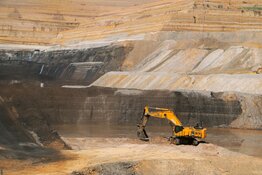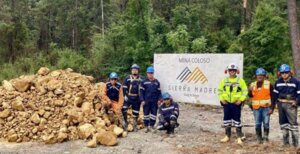The Gold Report: You have been involved in the mining space for some time, but not being a geologist or mining engineer, how do you approach the sector differently from other analysts?
Christos Doulis: I've been a banker and a research associate before becoming a mining analyst. I prefer to focus on producers, but I also cover advanced-stage developers. Generally, I look for production stories with market capitalizations of less than $1 billion (B). I focus on gold and silver, but have a stronger representation of silver than most industry analysts.
TGR: Is silver more interesting to you than gold at the moment?
CD: I'm equally interested in both gold and silver. However, silver is a much smaller space compared to gold for most mining analysts. Most analysts' coverage universe is gold; mine is 50/50 gold and silver.
TGR: You have a lot of great research available on your website at Stonecap. I noticed one of your covered companies appears to be a copper developer. How do base metals fit into your analysis?
CD: I am looking for outstanding companies. I don't cover anything that doesn't have a precious metal component. One company I cover has significant base metal value— Revett Minerals Inc. (RVM:TSX; RMV:NYSE.MKT), which has an approximately 50/50 silver–copper revenue mix.
TGR: Revett is a little different than most of your other companies. It is in Montana and it has been a long running story. Anything investors should be looking at there?
CD: Revett has been a sleepy story for quite some time. But, the Troy mine is a consistent money maker and it has a project called Rock Creek, which is an analog to Troy but ultimately could have a production profile five times larger. The project has been mired in permitting issues but it looks as if we're seeing light at the end of the tunnel. At the current stock price, investors get fairly valued cash flow from the Troy mine. The potential upside of Rock Creek comes for free.
"As long as the money supply grows faster than the precious metals supply, the price momentum for both gold and silver will continue to be positive."
The Troy mine by itself, at 1 million ounces (Moz) silver and 10 million pounds (Mlb) copper annual production, doesn't get anybody terribly excited, but it does provide cash flow. Rock Creek would produce 5 Moz silver and 60 Mlb copper annually. That's an asset that a senior mining company would be very interested in. Also, Revett is in a politically safe jurisdiction.
TGR: Can you tell us about some of the more typical producers that you cover?
CD: I like Argonaut Gold Inc.'s (AR:TSX) story. The company produces from heap-leach mines in Mexico. It has just done an acquisition in Ontario that is a bit of a change for the company. I have covered Argonaut with an Outperform rating for quite some time, but I have recently changed to a Sector Perform. Argonaut is a great company. Valuation is the question. Argonaut is trading at a very high multiple of next year's cash flow because it has two mines in production with two more coming soon. Based on next year's cash flow the company is fairly priced at around $11/share. With the stock trading at around $10.50/share, it's hard for me to get very excited. However, that is based on my long-term gold price of $1,350/ounce (oz). If you believe we are in an environment where we're going to see $1,700/oz as the long-term gold price, Argonaut has upside from here. That value is unlocked by building out the pipeline of new mines giving Argonaut a high torque to the gold price.
TGR: What does that production growth profile look like?
CD: Argonaut's current production is approximately 100,000 oz (100 Koz) per year. Production can grow to 200+ Koz annually among its three key assets—San Antonio, La Colorada and El Castillo. If Argonaut can successfully develop the Magino project from Prodigy Gold Inc., it will produce 400–500 Koz annually. That growth from 100 Koz to 500 Koz is the story that makes this an exciting company. It has one of the greatest exposures to growth in gold production in a junior miner today.
TGR: Do you have any silver producers you would like to talk about?
CD: I'm rating Aurcana Corporation (AUN:TSX.V; AUNFF:OTCQX) a Buy with a $1.60 target. The stock is currently at around $1/share. La Negra, its current producing mine, generates good cash flow. There is a question about recovery at La Negra. I noted that while the company's Q3/12 throughput was up 11%, silver production was barely up at all from Q2/12. It's either a recovery or a grade issue. I suspect that it is a recovery issue.
In my last note, I investigated Aurcana's historical recoveries, which appeared lower than the reported recoveries over the past 18 months. La Negra has a strong lead, zinc and copper byproduct stream so it is a very low-cost producer per ounce of silver on a net-of-credits basis. With production of 1.7 Moz at $5/oz cash costs in a $30+/oz silver price environment, that's top line approximately $40 million (M) of operating cash flow at the mine level. After factoring in capital expenditures, taxes and general and administrative expenses, the mine still generates significant positive free cash flow.
Aurcana's other project is the Shafter mine, which is targeting commercial production this quarter. Shafter at 1,500 short tons per day (stpd) should produce around 3.5 Moz silver annually. Aurcana's goal is to take it to 2,500 stpd, which would get it to about 5 Moz silver production annually. La Negra is currently running approximately 2,000 tpd with a goal of 3,000 tpd. The goal at La Negra is to increase the head grade from the current 80 grams per tonne (g/t) silver to near 100 g/t silver. If Aurcana could get it to 3,000 tpd, 100 g/t silver produces around 3 Moz silver annually. Both mines, with successful expansions, get Aurcana an annual production of 8 Moz silver. That is two-thirds the production of an industry leader like First Majestic Silver Corp. (FR:TSX; AG:NYSE).
Aurcana has a $500M market cap versus a $2.5B market cap for First Majestic. My base case outlines 5 Moz of annual silver production, which is 40% of First Majestic's silver production. That is 40% of the production trading at 20% of the value of a First Majestic. Even in my base case, I can see significant upside here.
TGR: What is your base case price for silver?
CD: $34/oz across the board. Silver itself is volatile and not easy to forecast. The price of $34/oz is close to where it's been trading for a while. The market looks to the spot price of silver as a valuation metric.
TGR: Would you like to tell us about other companies that you cover?
CD: SilverCrest Mines Inc. (SVL:TSX.V; SVLC:NYSE.MKT), despite the name, is a gold producer with a large silver credit. The Santa Elena mine produces about 550 Koz silver and about 30 Koz gold annually. At $1,700/oz, gold revenue totals $50M, while at $34/oz, silver revenue totals only $18M. In that light, Santa Elena is more accurately a gold mine with a silver credit.
The current process is heap leach, which works better on gold than it does with silver. That's why the gold recovery is 70% while the silver recovery is 30%. In the grand scheme, silver represents a quarter of the revenue stream.
TGR: Your report indicates SilverCrest just did a recent financing to retire its hedge book. Are there any other catalysts to move SilverCrest forward?
CD: SilverCrest has an exploration project called La Joya, which is low-grade bulk tonnage but on occasion it has pulled some higher-grade holes there. Another thing to watch for is the installation of a mill at Santa Elena. The original mine was built as a heap leach because the financing took place during the financial crisis and the company couldn't raise the money to build a mill. Now it is looking to build a mill. That will result in much higher silver recovery and better gold recovery. Production should increase from approximately 2 Moz silver equivalent (Ag eq) to around 4 Moz Ag eq. Remember when we are talking about those 2 Moz Ag eq, that's really slightly more than 0.5 Moz silver and then the other 1.5 Moz is gold as though it were silver.
Most of the catalysts are not really short term. However, a lot is planned for 2013 including ongoing work at La Joya, retiring the hedge book with the $30M it just raised and potentially doing a debt raise to fund the rest of the mill build out. By the end of 2013 SilverCrest should double its silver equivalent production.
TGR: Let's talk about a few companies that you cover that are squarely in the gold space. One that you cover is St Andrew Goldfields Ltd. (SAS:TSX). The share price has really taken a beating over the past year.
CD: St Andrew has struggled, but I think it has turned a corner. The company is not a high-grade operation and it has some heavy royalty payments from the vendors. The royalties are sliding-scale so the higher the price of gold goes, the higher the royalty is. While high gold prices are good for the company, royalties and costs have gone up faster than the gold price. I think the stock may have bottomed in the $0.30/share range area. I've had a Sector Perform on it for some time but have recently gone back to an Outperform.
Here is how I see the St Andrew story. The company has three operating mines and a 3,000 tpd mill. One of the mines is a low-grade open pit that is used to maintain mill feed at capacity. Going forward, we should see crowding out of that lower-grade ore from the pit with higher-grade ore from the Holt mine that has recently come on-line. The head grade at the mill should go up quarter over quarter. Additionally, St Andrew is bringing on a project called Taylor. That project includes a bulk sample in the near future that will produce some gold but, more importantly, push the project toward a 2014 operational start. At that time, I see St Andrew as a 125 Koz producer. It will be relatively high cost, but in a safe jurisdiction. Funding is complete for the mines and the mill. In summary, St Andrew has turned the corner and has a compelling story and valuation.
TGR: Another producer in a similar stock price trend and geography is San Gold Corp. (SGR:TSX.V). What is the story there?
CD: San Gold is another company that I was neutral on for some time and have recently gone positive. It's a situation where no more capital is needed to complete development. All required funding comes from internal cash flow and existing resources. San Gold had a real problem in the second quarter with its mill shut down for a month. That hit its Q2/12 numbers.
The new CEO, George Pirie, has started to turn San Gold around. Part of the current situation with the stock may be the result of the stock being oversold at the beginning, where the company was promoted as a 150 Koz high-grade producer. It's now a 100 Koz producer that is growing.
Both St Andrew and San Gold are stories that were promoted faster than they could deliver and the market punished them severely. At these price levels, both are buying opportunities.
TGR: Those are underground high-cost mines from Canada. Another producer you cover is Rio Alto Mining Ltd. (RIO:TSX.V; RIO:BVL) far south in Peru. The stock is performing extremely well. What is your outlook and is there still upside?
CD: I have been positive on Rio Alto in the past, but when it hit $4.50/share, I went to a Sector Perform. The stock continued to run to the $5.50/share range. In the past couple of weeks I have re-evaluated my position and went back to a Sector Outperform. I had been at a Sector Perform because I wanted to see an update on the oxides and/or an update on the sulfides. Rio Alto is mining the oxides now. I had some dialogue with management after the latest production numbers that led me to believe that I was underestimating the recoveries.
Furthermore, management convinced me that we would see some good news in either Q4/12 or the new year when the company tables a new mine plan for the oxide deposit. As long as there are no permitting issues, the mine should go to 36,000 tpd. That is 200 Koz/year for seven or more years from the La Arena project. That is at the top end of the previous range of 150–200 Koz, depending on the year and the mine sequencing. I expect the new plan to be no lower than 200 Koz/year.
I like Rio Alto's story because the company has executed well and a mine of that size is an obvious acquisition target for a major. Barrick Gold Corp.'s (ABX:TSX; ABX:NYSE) Lagunas Norte mine is nearby, providing synergies with procurement and infrastructure.
Then there is the sulfide project. I'm not necessarily 100% convinced on the merits of the sulfide project because it's been a long time since we've seen any economic numbers wrapped around it. Plus, input costs have gone up and the sulfides are not high-grade. The sulfide deposit adds potential sizzle to the story that there is life here beyond the oxide mine. Because of all of this, I am back to an Outperform here. Based on my models, the upside is limited. My target is $6.60, which is a 20% upside.
TGR: You just briefly touched on mergers and acquisitions as one exit strategy for these emerging midtier producers. Do you see any of these companies becoming consolidators in this space?
CD: Argonaut is a good example. First it did the Pediment acquisition and now it has done the Prodigy acquisition. Argonaut has paper that's priced at the high end of the range relative to near-term cash flow. That implies it may still be in acquisition mode. While this latest acquisition gives Argonaut all the horses in the stable to get to 400–500 Koz of production, its long-term goal, there's nothing to say it couldn't move the goal post and target becoming a 1 Moz producer.
TGR: Would you like to talk about other companies?
CD: A recent one that I've picked up is Alexco Resource Corp. (AXR:TSX; AXU:NYSE.MKT), which is a silver producer in Canada's Yukon. I've come out with an Outperform rating and a $5.75 target. The stock is around $3.75/share today. This was an $8/share stock that got crushed down to $3.50/share. I'm a little opportunistic here, but these sub-$4/share prices hold a lot of upside potential.
Alexco has had a little trouble in the last year with feeding its mill. The mill is rated at 400 tpd, but it has never been able to get it more than 300 tpd. Part of the reason is that Alexco only has had one mine, Bellekeno, feeding the mill. It is bringing on two other regional mines, Onek and Lucky Queen, in Q1/13. That will allow it to start feeding the mill at its rated capacity of 400 tpd, which will change it from a 2 Moz producer into a 3+ Moz producer. Alexco is in a politically safe jurisdiction and has very high grades. It's a prolific past-producing camp with lots of potential to find new discoveries.
TGR: The Yukon is not an inexpensive place to do business. What do cash costs look like?
CD: High cash costs in 2012 were one of the reasons the stock has been punished this year. Costs were in the $13/oz range, while in 2011 they were below $10/oz. Alexco should be able to get back to that $10/oz range when the mill feed gets to 400 tpd.
TGR: Are there significant co-products in that deposit? The economics of lead and zinc in remote areas can be a challenge.
CD: This is super high-grade ore with 700–800 g/t silver with around 5% each lead and zinc. The $10/oz number is net of credits. It takes these robust lead and zinc credits for this project.
TGR: You have mentioned a lot of projects with strong economics at current prices. Does it concern you that there's a lot of silver coming on-line from many diverse sources that could put downward pressure on the silver price?
CD: It is something to consider, but I expect the monetary base to grow faster than miners can bring the silver to market. There will be a lot of volatility in the silver price and massive ups and downs. However, as long as the money supply grows faster than the precious metals supply, the price momentum for both gold and silver will continue to be positive.
TGR: Do you have other comments?
CD: My research is available for readers who would like to get a more in-depth view of the companies that I cover. There is no cost associated with my research. It's primarily for an institutional audience, but I'm always willing to send copies of my reports to the retail shareholder. My email is cdoulis@stonecapsecurities.com.
TGR: Thanks for mentioning that. I was impressed with the depth and clarity of the reports. A lot of readers can benefit from that research. And thanks for your insights today.
Christos Doulis, before joining Stonecap Securities as a mining analyst in September 2010, spent 16 years in a wide variety of roles with a focus on the global mining sector. Most recently, Doulis was a partner at Gryphon Partners, a diversified global corporate advisory consultancy specializing in mining and resource company mandates. From 2006 to 2008, Doulis was a vice president in the Mining Investment Banking group at Blackmont Capital. Doulis began his professional career in 1994 with Scotia Capital as an equity research associate.
Want to read more exclusive Gold Report interviews like this? Sign up for our free e-newsletter, and you'll learn when new articles have been published. To see a list of recent interviews with industry analysts and commentators, visit our Exclusive Interviews page.
DISCLOSURE:
1) Alec Gimurtu of The Gold Report conducted this interview. He personally and/or his family own shares of the following companies mentioned in this interview: None.
2) The following companies mentioned in the interview are sponsors of The Gold Report: Revett Minerals Inc., Argonaut Gold Inc., Aurcana Corporation, SilverCrest Mines Inc. and St Andrew Goldfields Ltd. Streetwise Reports does not accept stock in exchange for services. Interviews are edited for clarity.
3) Christos Doulis: I personally and/or my family own shares of the following companies mentioned in this interview: None. I personally and/or my family am paid by the following companies mentioned in this interview: None. I was not paid by Streetwise Reports for participating in this interview.














































